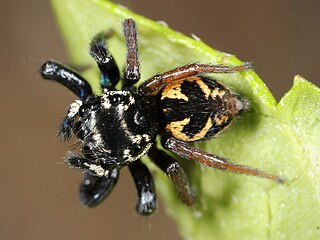Ashtabula is a genus of jumping spiders that was first described by G. W. Peckham & E. G. Peckham in 1894.
Avitus is a genus of jumping spiders that was first described by George and Elizabeth Peckham in 1896.

Balmaceda is a genus of jumping spiders that was first described by George Peckham & Elizabeth Peckham in 1894.

Breda is a genus of jumping spiders that was first described by George Peckham & Elizabeth Peckham in 1894.

Chira is a genus of jumping spiders that was first described by George Peckham & Elizabeth Peckham in 1896. It is currently named after Rio Chira, a river in Peru, but the Peckhams originally called the genus Shira, later emended by Eugène Simon.

Corythalia is a genus of jumping spiders that was first described by Carl Ludwig Koch in 1850. The genus is distributed throughout most of the Western Hemisphere. Species of this genus are found in The Americas.

Cotinusa is a genus of jumping spiders that was first described by Eugène Louis Simon in 1900.
Erica eugenia is a species of jumping spiders. It is the only species in the monotypic genus Erica. It was first described by George and Elizabeth Peckham in 1892, and is only found in Brazil and Panama.
Gastromicans is a genus of jumping spiders that was first described by Cândido Firmino de Mello-Leitão in 1917.

Lyssomanes is a spider genus of the family Salticidae, ranging from South and Central America, up to the southern United States.

Sarinda is a genus of ant mimicking jumping spiders that was first described by George and Elizabeth Peckham in 1892.

Sassacus is a genus of jumping spiders that was first described by George and Elizabeth Peckham in 1895. It is likely named after Sassacus, a Native American chief of the 16th and 17th century.

Synemosyna is a genus of ant mimicking jumping spiders that was first described by Nicholas Marcellus Hentz in 1846.
Titanattus is a genus of jumping spiders that was first described by George and Elizabeth Peckham in 1885. The name is a combination of "Titan" and the common salticid suffix -attus. It was merged with Agelista in 2017.

Zuniga is a genus of ant mimicking jumping spiders that was first described by George and Elizabeth Peckham in 1892. As of September 2019 it contains two species, found in South America, Costa Rica, and Mexico: Z. laeta and Z. magna. It is a senior synonym of Arindas and Simprulloides.

Actinopus is a genus of mygalomorph spiders in the family Actinopodidae. It was first described by Josef Anton Maximilian Perty in 1833 from the type species Actinopus tarsalis found in Brazil. The name is derived from Greek actin- "ray, beam" and pous "foot". It is a senior synonym of Aussereria, Closterochilus, Pachyloscelis, and Theragretes.

The Dendryphantina are a subtribe of jumping spiders that occur mainly in the New World. The subtribe was first defined by Anton Menge in 1879 as Dendryphantidae. Females of the subtribe generally show paired spots on the abdomen, and the males often have enlarged chelicerae. Females in this subtribe typically have S-shaped epigynal openings.

Colonus is a genus of spiders in the jumping spider family, Salticidae. Colonus species are endemic to North and South America, ranging from New York to Argentina. All members of the genus have two pairs of bulbous spines on the ventral side of the first tibiae. The function of these spines is unknown. Colonus was declared a junior synonym of Thiodina by Eugène Simon in 1903, but this was reversed by Bustamante, Maddison, and Ruiz in 2015.
Otiothops is a genus of palp-footed spiders that was first described by W. S. MacLeay in 1839.

Arachosia is a genus of anyphaenid sac spiders that was first described by Octavius Pickard-Cambridge in 1882.













